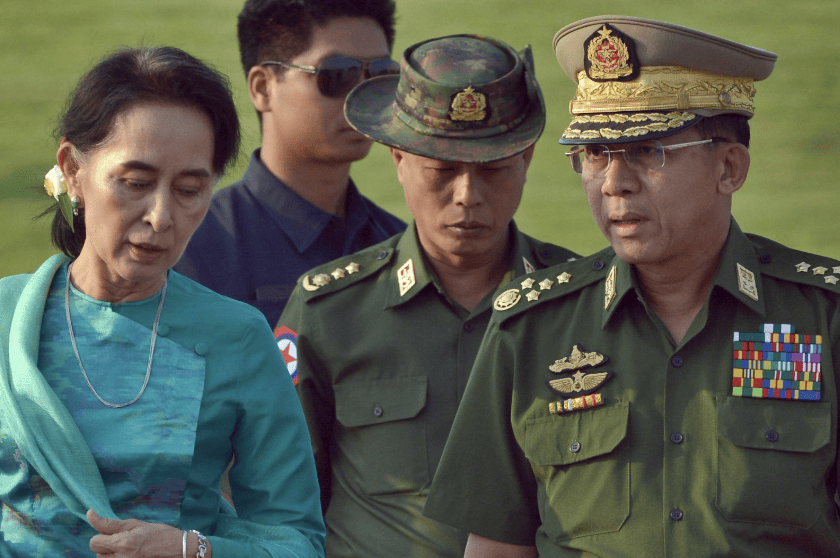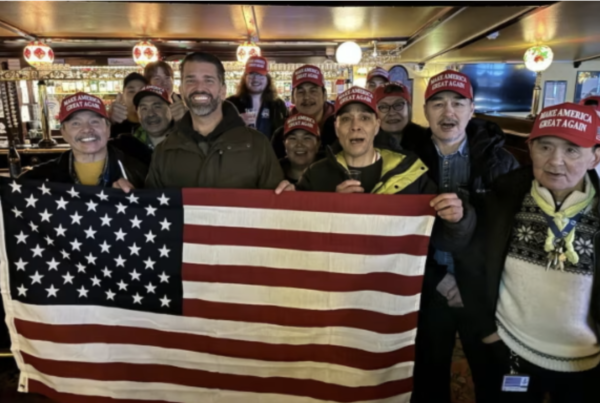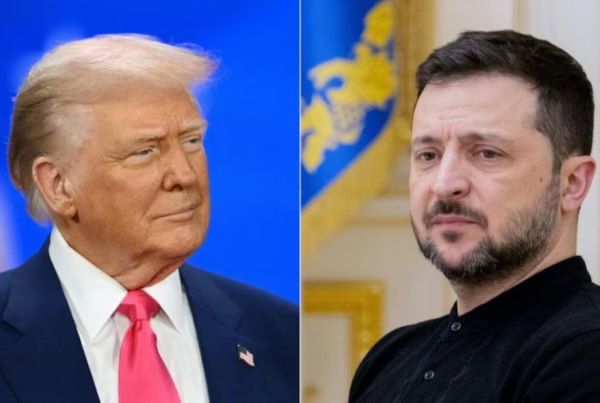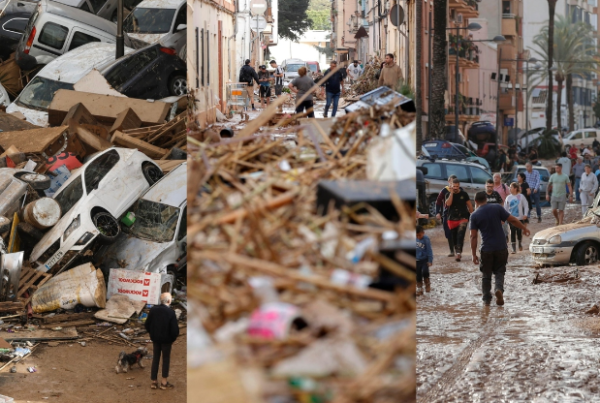Myanmar, formerly known as Burma, is a Southeast Asian nation bordering India, Bangladesh, China, Laos, and Thailand. A former British colony under the British Raj, it has struggled with government stability and democracy since gaining independence in 1948. The main democratic force in the country, the National League for Democracy, had been in power in a period of optimistic democratization since 2015. However, in February 2021 the military launched a coup d’etat, sparking rebellion across the nation. While the coup may have set off this latest round of conflict, such tensions have been present throughout Myanmar’s history.
Historical Primer
Myanmar in its contemporary form was born during the Japanese invasion of British Burma in World War II. As both sides devastated the landscape and local populations, multiple nationalist organizations formed and disbanded until the Anti-Fascist People’s Freedom League (AFPFL) was created in August 1944, led by Aung San. Having initially fought alongside Japan, the AFPFL worked post-war to negotiate with Britain and prepare for independence. The nation gained independence in 1948 as the Union of Burma with the AFPFL at its head. Immediately, the government had to grapple with a plethora of issues, as ethnic minority uprisings and demands for autonomy began, and spillover from the Chinese Civil War threatened local populations. Beyond security concerns, the new state had the immensely difficult task of attempting to develop modern infrastructure after the devastation from WWII. Due to this instability, democracy fell to a military coup d’etat in 1962 and would not return until 2011, leaving the nation in a near-constant state of brutal repression and armed uprisings for the remainder of the 20th century.
The Tatmadaw’s Domination
The Tatmadaw got their start in fighting as early as WWII. Shifting to anti-insurgency operations after the war, the organization strengthened significantly, as its soldiers quickly became highly experienced and suited for Myanmar’s harsh environment. Thus, when the civilian government continued to flounder into the 1960s, the leaders of the organization took action via coup d’etat, seizing power and using their armed superiority over any civil or ethnic resistance to remain dominant, in what was a brutally authoritarian period in Myanmar’s history. Military rule was marked by extreme crackdowns on dissent, high levels of corruption, and constant instability as rebellions continued to be rampant across the nation. Due to their preference for autarkic economics, the economy under Tatmadaw rule stagnated, crippling infrastructure and leaving a difficult starting point for building substantial industry or modern economic development at the turn of the 21st century.
Despite allowing a thaw and rolling back their total dominance over Myanmar’s political sphere, the Tatmadaw have, throughout the democratization process, been adamant about retaining a voice in constitutional change and government action. After ending multiple attempts to sideline their influence by the NLD, the Tatmadaw declared the previous year’s election results illegitimate and implemented restrictive measures to preempt dissent. Major protests broke out against the return of Tatmadaw rule, boiling over into armed conflict between the pro-democracy forces, coordinated by the NLD, and the government-backed Tatmadaw.
The NLD’s Democracy
In 2011, the military-backed government in Myanmar began to roll back certain authoritarian restrictions in what became a broader process of democratization. While the Tatmadaw never lost influence in the governing process, the decade from 2011 until 2021 saw real, substantial improvement in the political situation of the nation. In 2015, free elections resulted in a massive triumph for the National League for Democracy (NLD) led by Aung San Suu Kyi, the daughter of Aung San. During the democratic period, various improvements were made: civil rights improvements, economic development occurred, and reforms to public services such as health and education were passed. However, the NLD was unable to enshrine democracy in a strong constitution, hindered by the Tatmadaw’s influence on constitutional change.
Initially hailed as a beacon of hope for the nation by the international community, the NLD had positive relations with Myanmar’s many ethnic groups, helping spur the democratization process further. Sadly, this hope waned over time, due to poor policy decisions in some areas and lack of action on key issues of civil rights and genocide. The NLD found it much harder to maintain stability despite retaining majority support from voters.
Sensing the uncertainty in government, the Tatmadaw launched its coup on February 1, 2021, arresting Aung San Suu Kyi and seizing power. In response, NLD lawmakers created a rival government, and for the past three years have been coordinating both civilian and military resistance to Tatmadaw rule. By both supplanting the military government internationally, and encouraging civil disobedience, the NLD’s rival government has formed an opposing force to be rallied around, leading to their call for an uprising against the Tatmadaw government.
Ethnicity, Warfare, & Genocide
This call has been answered by the many minority ethnic groups that are spread across the country. Alongside the majority Bamar, or Burman, the government recognizes hundreds of smaller groups, combined into “major national ethnic races” of the Chin, Kachin, Karen, Kayah, Mon, Rakhine, and Shan groups. Most of these groups historically have fought for their own autonomy in a federalized Myanmar, and have been consistently fighting against the Tatmadaw almost since independence. Since the 2021 coup, ethnic minorities have either been fighting the Tatmadaw alone, coordinating with the NLD counter-government, or combining their forces with other tribes. The Three Brotherhood Alliance, a combination of armed groups from the Arakanese, Shan, and Ta’ang minorities, has been a major force in resisting Tatmadaw advances, reaching a large enough scale for the government to at least feign peace talks, which the alliance denies ever accepting.
Beyond the recognized minorities, it is also necessary to mention the Rohingya, who were victims of genocide and forced relocation beginning in 2017, with the military forcing 730,000 Rohingya to flee to Bangladesh. Despite holding power at the time, the NLD did not condemn the actions, instead condoning the Tatmadaw’s campaign, ignoring demands for justice. The lack of action or accountability from the government soured its relations with the international community and tarnished Suu Kyi’s global reputation as a champion of human rights.
A Humanitarian Crisis & Failing International Response
The breakdown of order in Myanmar since 2021 has caused various issues in the nation to compound further into a broader humanitarian crisis. Firstly, the collapse of government authority also ended major state-led responses to the COVID-19 pandemic, making disease rampant and a major health concern for most of the population, particularly in the dense urban centers of Yangon (formerly Rangoon) and Nay Pyi Taw. Beyond this, organized crime and forced labor actions have sprung up throughout the remote areas of the nation, especially in the northeast near the Chinese border. Drug production has increased, with Myanmar overtaking Afghanistan as the world’s largest opium producer in 2023. Food insecurity has become a major issue for many as trade becomes increasingly difficult and harvests are ruined by the conflict. Since the 2021 coup, Myanmar now ranks as the second most authoritarian nation globally according to The Economist’s Democracy Index (2022), above only Afghanistan. While any one of these issues would be a crisis on its own, their combined effect on Myanmar has led the UN to express concern at the “deadly freefall into even deeper violence and heartbreak.” Unfortunately, the UN has not done much to help alleviate these issues.
These issues are largely ignored by the international media, in favor of conflicts that are more controversial or “relevant” to Western audiences. Because of this, few international actors devote substantial time to Myanmar’s issues. China is currently Myanmar’s main ally, seeking cooperation to secure the border between the two countries and opportunities for investment. Its vote on the UN Security Council, along with Russia’s, has continued to prevent major UN interventions in Myanmar. The other major bloc Myanmar is a part of, the Association of Southeast Asian Nations (ASEAN), has refused to decrease trade with the Tatmadaw junta, and instead insists that Myanmar remains a part of the Southeast Asian community regardless of its governance.
With Suu Kyi under house arrest, creating challenges for a unified resistance front, and the civil war in Myanmar continuing to rage on without a clear end for either side, it is anyone’s guess how or when the dust will settle. As civilians continue to suffer without the international community’s attention, Myanmar remains a little-discussed flashpoint of conflict, humanitarian crisis, authoritarian governance, organized crime, that over 54 million people continue to live in, hoping for a return of freedom, democracy, peace, and stability.
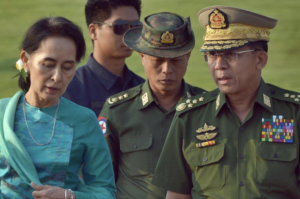
Aung Shine Oo/AP
A special thank you to Jules Kyi for their assistance in the making of this article.
Other posts that may interest you:
- The Trouble with ‘Ecocide’
- Carbon dioxide removal – hit or miss?
- Local Victories for Turkish Opposition — A Sign of Hope?
- Are France and Japan a Mismatch Made in Heaven?
- A Reflection on Dark Tourism
Discover more from The Sundial Press
Subscribe to get the latest posts sent to your email.


